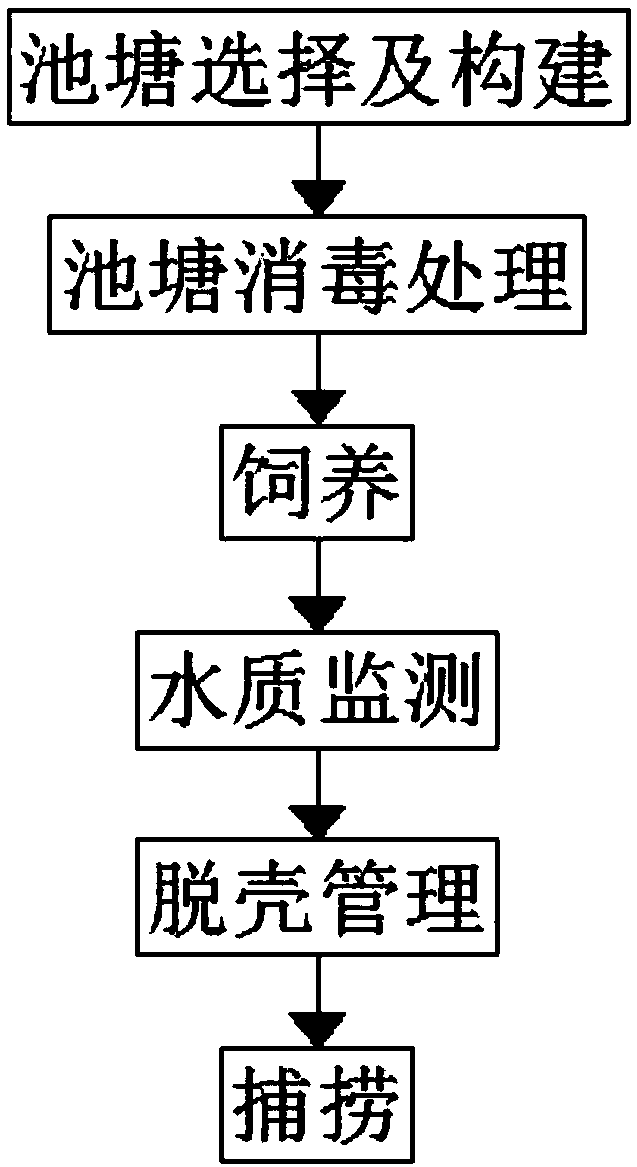Method for breeding crays
A breeding method and lobster technology, applied in the field of lobster farming, can solve problems such as poor taste of lobster, unfavorable interests of farmers, failure to improve the growth rate of lobster, and achieve the effect of increasing the growth rate
- Summary
- Abstract
- Description
- Claims
- Application Information
AI Technical Summary
Problems solved by technology
Method used
Image
Examples
Embodiment 1
[0021] see figure 1 , a crayfish cultivation method, its cultivation method comprises the following steps:
[0022] A. Pond selection and construction: Choose a pond with sufficient water source and no silt, or manually dig a pond with an excavator, and make the pond deep 1.2-2.5m. The pond is divided into shallow water area and deep water area. The depth of the shallow water area is 0.9- 1.2m, the depth of the deep water area is 1.7 ~ 2.2m, and the ratio of the shallow water area to the deep water area of the overall pond area is 3:1. Then build mud stems in the middle of the pond for crayfish to dig holes, and build slopes around the pond To prevent the crayfish from burrowing and escaping, and set up isolation nets around the slope of the pond. The isolation nets are 0.6-0.7m high, and the isolation nets are inserted into the pond ground by 40-47cm. There are 3 water inlets and 1 water outlet in the pond. , each water inlet is equipped with three layers of filter screen,...
Embodiment 2
[0029] A kind of crayfish culture method, its culture method comprises the following steps:
[0030]A. Pond selection and construction: Choose a pond with sufficient water source and no silt, or manually dig a pond with an excavator, and make the pond deep 1.2-2.5m. The pond is divided into shallow water area and deep water area. 1.2m, the depth of the deep water area is 1.8 ~ 2m, and the ratio of the shallow water area and the deep water area to the overall area of the pond is 3:1, then build mud stems in the middle of the pond for crayfish to dig holes, and build ramps around the pond Prevent crayfish from burrowing and escaping, and set up isolation nets around the slope of the pond. The isolation nets are 0.6-0.65m high, and the isolation nets are inserted into the pond ground by 40-45cm. There are 4 water inlets and 3 water outlets in the pond. Each water inlet is equipped with four layers of filters, and the first layer of filters is a 20-mesh metal mesh cover, the sec...
PUM
| Property | Measurement | Unit |
|---|---|---|
| Thickness | aaaaa | aaaaa |
| Thickness | aaaaa | aaaaa |
| Thickness | aaaaa | aaaaa |
Abstract
Description
Claims
Application Information
 Login to View More
Login to View More - R&D
- Intellectual Property
- Life Sciences
- Materials
- Tech Scout
- Unparalleled Data Quality
- Higher Quality Content
- 60% Fewer Hallucinations
Browse by: Latest US Patents, China's latest patents, Technical Efficacy Thesaurus, Application Domain, Technology Topic, Popular Technical Reports.
© 2025 PatSnap. All rights reserved.Legal|Privacy policy|Modern Slavery Act Transparency Statement|Sitemap|About US| Contact US: help@patsnap.com

